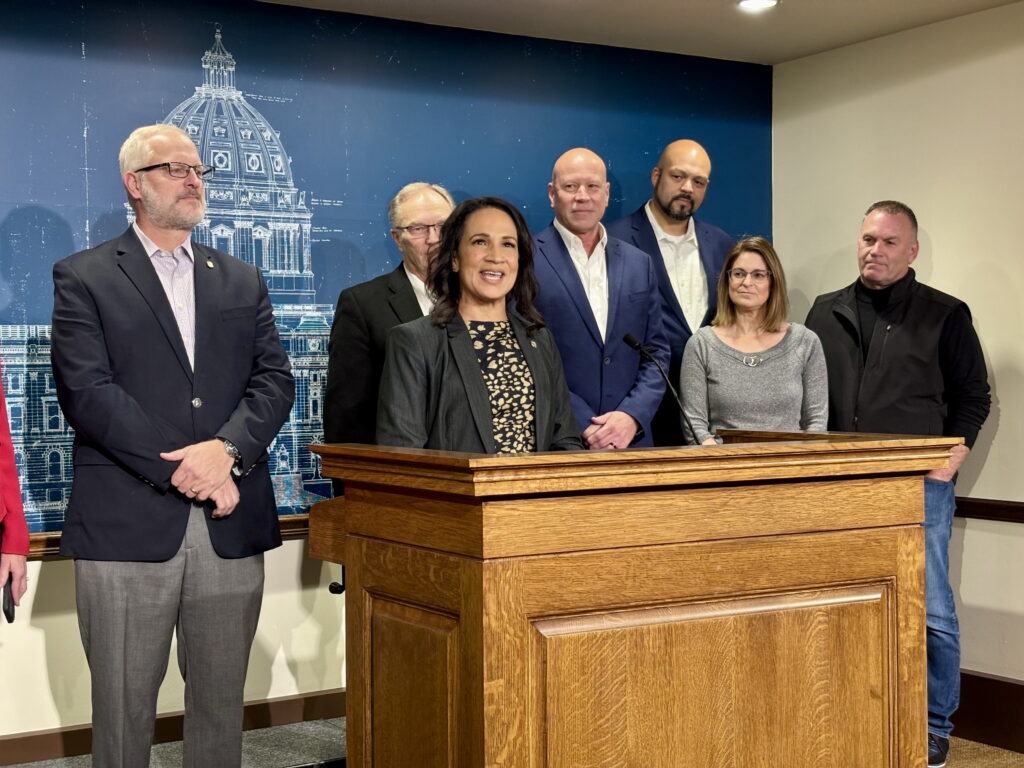
House Minority Leader Lisa Demuth, R-Cold Spring, and House Republicans at a Capitol press conference on Nov. 6, 2024. House Republicans flipped three seats, ending the DFL’s trifecta over state government. Photo by Michelle Griffith/Minnesota Reformer.
Republican and Democratic lawmakers acknowledged Wednesday that they will now have to put grudges aside and work together under a tied 67-67 Minnesota House.
Unofficial election results show that the party breakdown is split between Democrats and Republicans in the Minnesota House, effectively ending the two-year Democratic-Farmer-Labor trifecta control of state government. Republicans flipped three key swing districts on Tuesday.
DFL incumbents in two House Districts won their races by razor-thin margins, according to preliminary election data last updated on Wednesday afternoon. Rep. Dan Wolgamott, DFL-St. Cloud, won by 28 votes, and Rep. Brad Tabke, DFL-Shakopee, won by 13 votes. These results will likely be recounted, though they are expected to remain the same.
Democrats still control the Minnesota Senate and the governor’s office. Divided government in recent years has often led to acrimony and stalemate; in 2017, then-Gov. Mark Dayton and the GOP-controlled Legislature wound up in litigation when he vetoed their operating budget.
“It’s become nearly impossible. We don’t have a good record in the 21st century with divided government,” said Lori Sturdevant, a Minnesota political historian and former member of the Star Tribune editorial board. In 2022, for instance, the DFL-controlled House and the GOP-controlled Senate couldn’t agree on a big public works bill that’s long been a regular feature of even-yeared legislative sessions.
House Minority Leader Lisa Demuth, R-Cold Spring, during a Capitol press conference Wednesday said that her caucus is ready to work together with Democrats, even though they were hoping to clinch the majority.
“This is a perfect opportunity … for us to work together with our (Democratic) colleagues and bring civility back where there’s been a lack of that, as we have seen,” Demuth said. “We want to work together to serve Minnesotans in the best way. We’ve had good working relationships over time in certain areas. This will expand that.”
House Speaker Melissa Hortman, DFL-Brooklyn Park, echoed Demuth’s remarks, noting the caucuses will work together to craft a two-year budget agreement before a June 30 deadline, after which a government shutdown looms.
“Minnesotans certainly sent us a tied Minnesota House. What they are asking us to do is work together and be productive, and we are fully prepared to do that,” Hortman said.

In the coming days, Democrats and Republicans will have to hash out a power-sharing agreement to decide which party will control the House speakership and what party will chair committees. Demuth and Hortman said they haven’t made any decisions yet.
The Minnesota House was last tied in 1979, with 67 DFL members and 67 Independent-Republicans, as today’s Republicans were then called. House members began the 1979 session with amicable negotiations, but it ended in bitter fighting — resulting in a one-day special session, according to House Public Information Services.
Hortman said “geographic realignment” was the main reason the DFL lost the majority and three House seats, noting that rural areas of the state are becoming more red and suburbs more blue.
She said that trend has always accelerated when Donald Trump has been on the ballot.
“When you try to flip a seat from Republican to Democrat in a year that’s trending Republican, that’s a tall order,” Hortman said.

